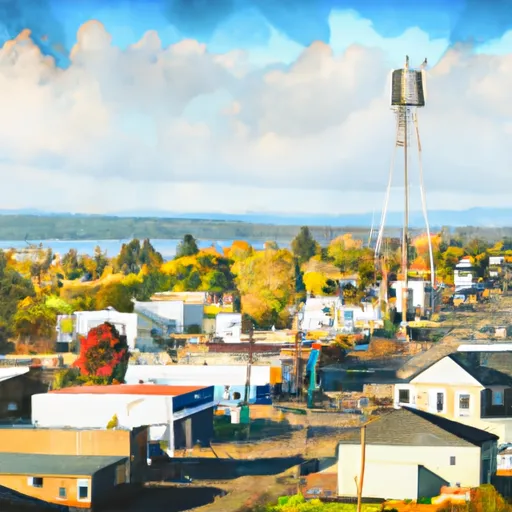-
 Snoflo Premium
Snoflo Premium
Get unlimited access to all our content
With no Ad interruptions! - Start Your Free Trial Login with existing account
Raymond
Eden Index
Climate
5.5
•
Recreation
•
Community
2.5
•
Safeguard
2.8/10

Raymond is a charming city situated in Pacific County, Washington. It experiences a mild coastal climate influenced by the Pacific Ocean. Summers are mild and dry, with average temperatures ranging from 60°F to 70°F (15°C to 21°C). Winters are cool and wet, with temperatures typically ranging from 40°F to 50°F (4°C to 10°C). The region receives abundant rainfall throughout the year, with an annual average of around 80 inches (200 cm). This creates lush, green surroundings and supports the diverse hydrology constituents in the area.
Raymond is surrounded by numerous water bodies, including the Willapa River, Smith Creek, and pristine lakes. These water sources offer fantastic opportunities for fishing, boating, and kayaking. The Willapa River, in particular, is renowned for its salmon and steelhead runs, attracting anglers from near and far. The city also boasts several parks and nature reserves, such as Willapa Hills Trail and the nearby Willapa National Wildlife Refuge. These areas provide excellent opportunities for hiking, bird watching, and wildlife observation.
In conclusion, Raymond, Washington offers a favorable coastal climate, abundant rainfall, and a variety of hydrology constituents. The city's proximity to water bodies and natural reserves provides ample opportunities for engaging in outdoor activities and enjoying the stunning natural beauty of the region.
What is the Eden Index?
The Snoflo Eden Index serves as a comprehensive rating system for regions, evaluating their desirability through a holistic assessment of climate health, outdoor recreation opportunities, and natural disaster risk, acknowledging the profound impact of these factors on livability and well-being.
Climate Health Indicator (CHI): 5.5
Raymond receives approximately
2108mm of rain per year,
with humidity levels near 86%
and air temperatures averaging around
10°C.
Raymond has a plant hardyness factor of
8, meaning
plants and agriculture in this region tend to thrive here all year round.
By considering the ideal temperature range, reliable water supplies, clean air, and stable seasonal rain or snowpacks, the Climate Health Indicator (CHI) underscores the significance of a healthy climate as the foundation for quality living.
A healthy climate is paramount for ensuring a high quality of life and livability in a region, fostering both physical well-being and environmental harmony. This can be characterized by ideal temperatures, reliable access to water supplies, clean air, and consistent seasonal rain or snowpacks.
Weather Forecast
Streamflow Conditions
Washington Coastal
Area Rivers
Washington Coastal
Snowpack Depths
Washington Coastal
Reservoir Storage Capacity
Washington Coastal
Groundwater Levels
Recreational Opportunity Index (ROI):
The Recreational Opportunity Index (ROI) recognizes the value of outdoor recreational options, such as parks, hiking trails, camping sites, and fishing spots, while acknowledging that climate plays a pivotal role in ensuring the comfort and consistency of these experiences.
Access to outdoor recreational opportunities, encompassing activities such as parks, hiking, camping, and fishing, is crucial for overall well-being, and the climate plays a pivotal role in enabling and enhancing these experiences, ensuring that individuals can engage in nature-based activities comfortably and consistently.
Camping Areas
| Campground | Campsites | Reservations | Toilets | Showers | Elevation |
|---|---|---|---|---|---|
| Lake Sylvia State Park | 35 | 137 ft |
Catastrophe Safeguard Index (CSI):
The Catastrophe Safeguard Index (CSI) recognizes that natural disaster risk, encompassing floods, fires, hurricanes, and tornadoes, can drastically affect safety and the overall appeal of an area.
The level of natural disaster risk in a region significantly affects safety and the overall livability, with climate change amplifying these risks by potentially increasing the frequency and intensity of events like floods, fires, hurricanes, and tornadoes, thereby posing substantial challenges to community resilience and well-being.
Community Resilience Indicator (CRI): 2.5
The Community Resilience Indicator (CRI) recognizes that education, healthcare, and socioeconomics are crucial to the well-being of a region. The CRI acknowledges the profound impact of these elements on residents' overall quality of life. By evaluating educational resources, healthcare accessibility, and economic inclusivity, the index captures the essential aspects that contribute to a thriving community, fostering resident satisfaction, equity, and social cohesion.

